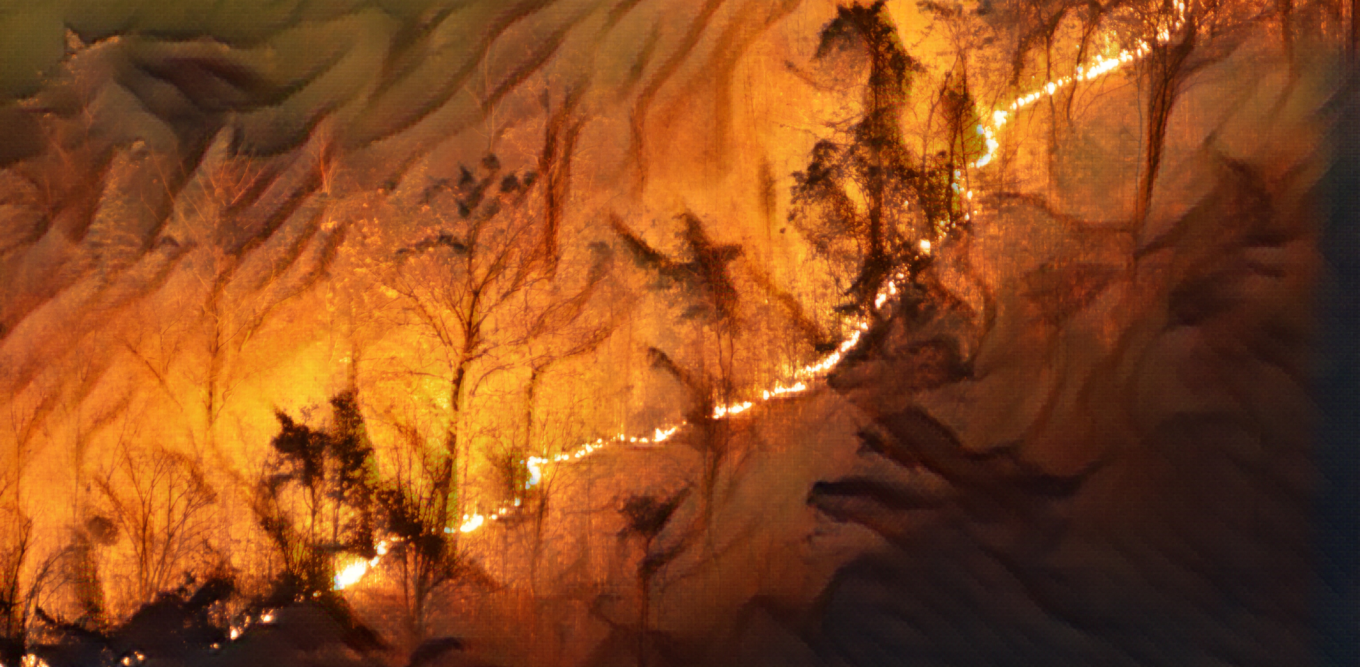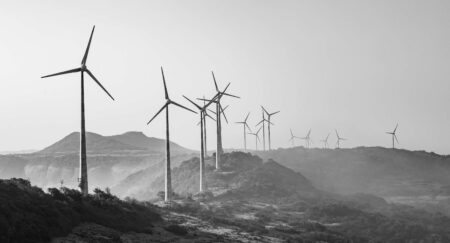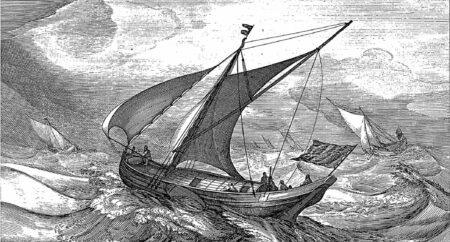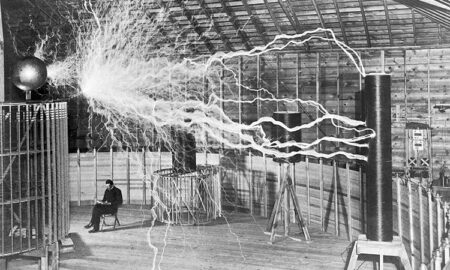The rise of extreme wildfires, driven by human-induced climate change, has and will continue to reshape the lives of millions across Europe. Without collective action, many regions face an uncertain future.
In 2022, EU nation states experienced a record-breaking wildfire season. According to the European Forest Fire Information System (EFFIS) total burnt land exceeded 750,000 hectares, more than double the previous decade average.
Historically, the continent’s wildfires have played a positive role in the lifecycle of ecosystems by removing dead vegetation and promoting new growth. However, the intensity and regularity of large wildfires in recent years represents a departure from the norm. Consequently, ecosystems now struggle to recover from prolonged periods of burning, leaving them dry and scarred.
Beyond the environmental consequences, communities residing in close proximity to wildfire activity face numerous challenges. These include economic disruptions, the loss of cultural landmarks, displacement of families, and overwhelming demands on limited public health resources.
Fortunately, amidst the escalating severity of wildfires, promising mitigation strategies have emerged. These preventative measures, which involve the restoration of forest ecosystems, offer vulnerable communities the best chance to combat fires and safeguard their homes and livelihoods.
What EU regions are most affected?
The wildfire crisis stretches across most parts of Europe, affecting countries from Greece in the southern mediterranean to Romania on the eastern edge of the continent.

Certain nations, however, are on the frontline of this crisis. In 2022, France, Germany and Spain were part of a group of nine EU states that saw national records for fire damage fall.
Spain
Spain suffered a particularly devastating wildfire season. Emergency services fought nearly 50 major fires resulting in over 300,000 hectares of burnt land (Statista, 2022). Normally, the southern European nation only averages 66,965 hectares of fire damage per season.

Find more statistics at Statista
Wildfires in Spain present many challenges to the people and government, most concerningly desertification. Desertification is a process where ecosystems lose much of their biodiversity and begin to resemble arid deserts. The spread of arid land puts significant pressure on water resources and soil quality.
A UN environmental committee revealed that 74 percent of Spanish territory is at risk of desertification, primarily due to heatwaves and wildfires, with 18 percent at high risk of a permanent transformation. The Canary Islands and the region of Murcia are most vulnerable.
France
France suffered a loss of 65,660 hectares of land in 2022, six times the average of the last 18 years (EFFIS).

Find more statistics at Statista
The 2022 fire season was an outlier for France because the largest fires occurred in the southwest. Usually wildfire events tend to concentrate in the southeast of the country which neighbours the Mediterranean.
The growing problem of wildfires, particularly in Gironde, has the potential to disrupt the production of one of the region’s most popular exports, wine.
One particularly out of control fire, fought by over 1,000 firefighters, threatened famous vineyards in Bordeaux’s Graves and Sauternes districts. Luckily, the vines escaped destruction through a change in wind direction and the efforts of fire services.
Despite this moment of good fortune for Bordeaux’s winemakers, the wider industry have expressed fears that lingering smoke could spoil the taste of the upcoming grape harvest.
Germany
High temperatures in Germany, combined with a lack of rainfall, sparked a summer intense of wildfires. Official statistics revealed that over 4000 hectares of land was burnt from a total of 32 fires (EFFIS).

Find more statistics at Statista
32 total fires may seem like a relatively small number compared to France and Spain. However, Germany historically has very mild fire seasons. In fact, records show that between 2008-2012 the country experienced zero wildfire events.
The global impact of European wildfires
Wildfires in Europe have far-reaching consequences for the planet.
The toxic smoke from a major fire has the potential to drift thousands of miles from its source. So, depending on wind conditions, smoke clouds can end up polluting multiple regions and their ecosystems.

A recent One Earth study confirmed that fires in Europe, and other parts of the northern hemisphere, contribute to the warming of the Arctic. So-called ‘brown carbon’ – released from burning vegetation – plays a more significant role in melting polar ice than previously thought.
The climate scientists concluded that brown carbon was responsible for twice as much warming as black carbon, a byproduct of fossil fuel production (Yue et al., 2022).
What is the link between wildfires and climate change?
Although the majority of wildfires start due to avoidable human error, such as incorrect waste disposal, climate change has created the perfect conditions for them to spread.
As mentioned, the presence of brown and black carbon in the atmosphere has had a warming effect on the planet. Warmer weather, including extreme highs, has become the norm for much of Europe. Last summer, heatwaves in several European cities, such as London, saw temperatures break 40 degrees celsius for the first time.
A warmer climate, inevitably, leads to a dry landscape as moisture is drawn from the soil and plant life. Bone dry soil and dead vegetation, typical features of drought, act like a natural ‘fuel’ for any live fire.
In short, the brown carbon, released from recent fires, will end up laying the foundation for more fires in the coming years. This phenomenon is called a feedback loop, where the output of one event becomes the input for th犀利士 e production of similar events in the future.
Data from CAMS Global Fire Assimilation System (GFAS) predicts that fires from June – August in the EU and UK created upwards of 6.4 mega tonnes of carbon, a 15 year high.
Aside from carbon pollution, climate change drives wildfire activity by weakening the natural defenses of forest ecosystems. Certain species of insects and plants that harm tree growth have thrived in the hotter summers and milder winters.
One example of a potent forest pest is the mountain pine beetle. This particular species obstructs the movement of food between the leaves and roots by tunnelling into the bark. Over the past few years, populations of the beetle have greatly increased resulting in infested forests and more dead trees. Dead trees add to the natural fuel load for a potential fire.
What are the public health implications?
Extensive research conducted worldwide has shed light on the public health implications of intense wildfire seasons. The findings consistently demonstrate that wildfires have significant short and long-term effects on affected populations.

One prominent trend from the fire season is a decline in respiratory health. Typical smoke-related respiratory issues include shortness of breath, lung irritation and persistent coughing. These issues may be temporary or a symptom of a permanent condition.
A study (Tornevi, et al., 2021), conducted after a high occurrence of wildfires in Jämtland Härjedalen Sweden, revealed an increase in the number of residents complaining of breathing difficulties. Additionally, all eight health authorities included in the study observed a noticeable surge in asthma-related visits.
Apart from exacerbating respiratory health, wildfires have been linked to life-altering illnesses, including cancer. Prolonged exposure to smoke pollution places communities at risk of developing brain and lung tumours.
The Lancet published evidence suggesting that communities living in close proximity (around 50 km) to wildfires had a 10 percent higher incidence of brain tumours compared to unexposed populations. The scientists (Korsiak, J., et al, 2022) offered this opinion after reviewing medical data in Canada across a 20 year period.
Physical conditions, such as asthma, aren’t the only serious health problems associated with wildfires. Individuals who have witnessed a fire or have lost their home will likely suffer some degree of mental trauma.
Drug utilisation statistics from northern Spain, illustrate the extent to which wildfires have a detrimental effect on people’s mental health.
The Galician study (Caamano-Isorna, F., et al, 2011) revealed that wildfire activity led to a higher consumption of anxiolytics and hypnotics among men. Anxiolytics and hypnotics are types of prescription drugs used to treat anxiety and insomnia, respectively.
What happens to the air during a wildfire?
The smoke emitted from wildfires is made up of several toxic pollutants. However, particle pollution represents the biggest danger to public health.
Particle pollution, also referred to as particulate matter (PM), consists of tiny fragments of solids and droplets of liquids. The solids may be biological matter such as soil and dirt or inorganic materials like metals.
The solids and liquids of various compositions also vary in size. Generally, they fall into two distinct categories – coarse and fine. The fine particles measure to less than 2.5 micrometers in diameter, many times smaller than a single grain of sand.
These fine particles are key to driving hospitalisations post wildfire because they can easily pass into the lungs and bloodstream.
What are the economic consequences of wildfires?
Rising cost of suppression and recovery
The first clearly measurable economic impact of wildfires is the cost of fire suppression and recovery.
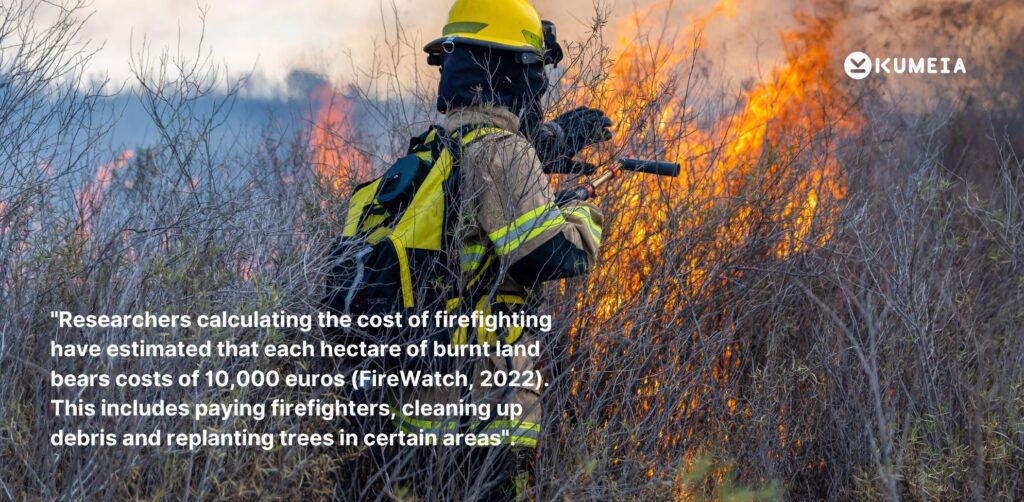
The prevalence of large fires, which burn for multiple days, has required governments to employ increasing numbers of firefighters, supported by expensive technological assets such as planes and other aircrafts.
Researchers calculating the cost of firefighting have estimated that each hectare of burnt land bears costs of 10,000 euros (FireWatch, 2022). This includes paying firefighters, cleaning up debris and replanting trees in certain areas.
In reaction to the crisis, the EU project rescEU received new funding of 170 million euros. The project, which has been set up to protect citizens from major disasters, will purchase more aerial and ground reinforcements.
Labour market volatility
Aside from the direct costs of extinguishing fires, wildfires disrupt local and national economies in several different ways. One example, explored by US researchers in Oregon, is the volatility it brings to local labour markets.
Employment and wages during and in the immediate aftermath of a wildfire event, contrary to our common belief, tend to increase. This positive trend is due to firefighters and other emergency service personnel descending into communities and using hospitality and accommodation facilities.
However, the long term picture is more uncertain. Affected towns and communities experience slow growth and instability in terms of job opportunities. Analysis from the Ecosystem Workforce Program shows some specific sectors, often central to certain local economies, suffer more than others.
For the recreation, tourism and manufacturing sectors, the job rate does not recover quickly for a myriad of reasons, including the changed perception of the area. For example, tourists might be reluctant to return to a place that has experienced large fires.
Loss of agricultural commodities
Wildfires, partnered with the extreme heat, have placed significant pressure on agricultural workers amid crop losses.
On one UK farm, a farmer accidentally started an ‘open-land fire’ during a drought. When cutting his field with a combine harvester a fire ignited and burned through many of his standing crops (Claire M. Belcher., et al, 2018).
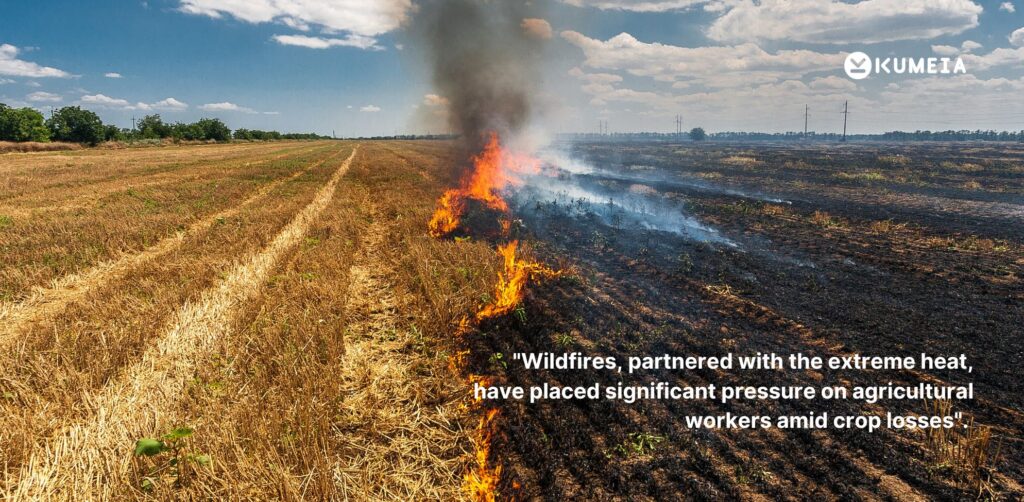
The British farm’s loss was relatively small, only 30 hectares. However, the incident shows how farmers, operating widely used equipment, can lose crops and revenue. Due to cases like this, many farmers in France now perform harvesting at night to avoid fires (Guardian, 2022).
On a macro level, Europe has suffered sizeable losses of key agricultural products. Coldiretti, the Italian Farmers Association, estimated that the drought conditions would lower their seasonal harvest of rice and corn by a third, at a cost of approximately 3 billion.
Wheat, another crucial commercial crop, has recorded a poor annual yield. Wheat is very susceptible to a combustion event because at harvest the crop holds low levels of moisture, only 18 – 24 percent. In 2022, the EU Commission lowered their estimated output of soft-wheat by 5 million tonnes.
What does successful mitigation look like?
Land management
Understanding that wildfires occur on open farmland as well as forests, the agricultural sector will have to adapt their processes.
One mitigation tactic to avoid wildfires is to periodically burn land with low-intensity fires. Although fighting fire with fire seems counterintuitive, small fires have always played a crucial part in shaping the landscape and promoting biodiversity. Performing controlled burns on farmland can reduce the natural fuel load and control populations of invasive species.
Ecosystem restoration
In order to combat the wildfire crisis in forested areas, Europe needs to transform the current state of its forests.
The EU Commission published a report in 2020 outlining the ways forest stakeholders could adapt their current approach. New strategies focus on addressing the primary problem of natural fuel loads, in other words, flammable vegetation.
The practical steps to deal with combustible vegetation include: prescribed burns, physical removal, fire breaks to avoid accumulation and the introduction of less fire-prone plant species such as deciduous trees.
The Commission has used the term ‘mosaic landscape’ to describe the ideal outcome of the changes to land and forests. In essence, the EU wants to avoid the mistakes of tree planting projects of the past and build diverse ecosystems which enhance natural biodiversity.
Awareness campaigns
Climate-resilient ecosystems will help break the cycle of extreme wildfires. However, the majority of fires are caused by human behaviours, meaning communities need guidance about how to safely enjoy visits to forested areas.
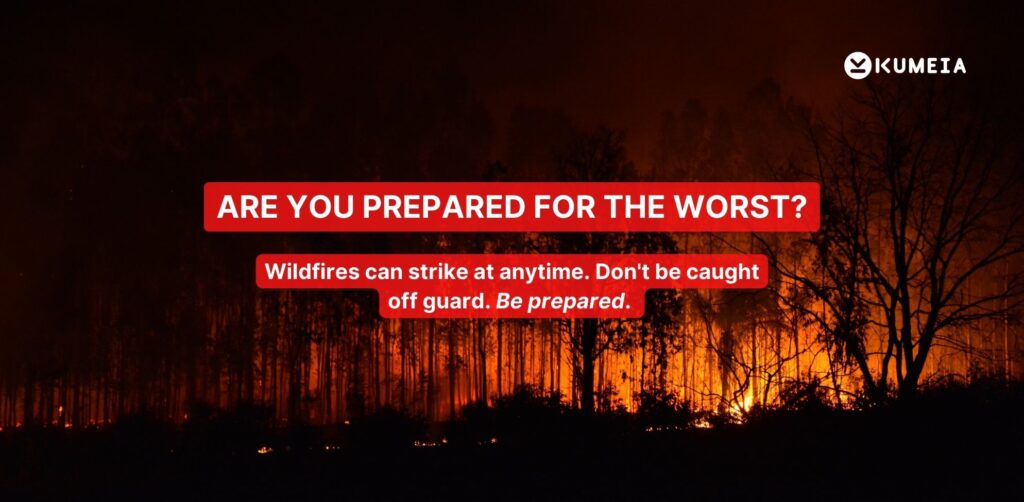
Advice for forest visitors includes: correctly dispose of any waste such as cigarettes and batteries, repair any equipment or vehicles in bad condition and keep any open flames away from dry vegetation.
The promotion of fire safety rules has been proven to reduce the number of man-made fires. In the US state of Utah, a public awareness campaign aimed at residents and tourists, called Fire Sense, had a positive impact. After publication in 2020, the state experienced 922 fewer human-caused fires the following year (Utah Gov, 2021).
Ultimately, governments and local authorities will have to direct more funds to mitigation tactics rather than suppression efforts. The UN Environmental program (UNEP) suggested current funding patterns across the globe favoured suppression, with as little as one percent going to planning and prevention activities.

